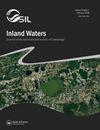墨西哥内陆水域的温室气体排放:使用升级方法的初步估计和不确定性
IF 2.3
3区 环境科学与生态学
Q1 LIMNOLOGY
引用次数: 3
摘要
传统的内陆水域温室气体(GHG)排放估算升级方法是不精确的,但基于环境驱动因素的更精确方法是一个长期挑战。墨西哥缺乏其内陆水域的温室气体排放估算,而且只有稀疏但经过科学验证的信息可用。本研究利用来自26个不同水体和一个本地和另一个全球表面积数据集(INEGI和HydroLAKES)的4275个温室气体通量测量值,首次提供了墨西哥内陆水域的温室气体排放估算。对温室气体排放因子进行了计算,随后对其进行了升级,以估算来自内陆水域的全国温室气体排放总量,并与基于平均全球排放因子或规模-生产力加权(SPW)模型的其他排放措施进行了比较。意味着(标准误差)年度通量从内陆水域都是2.2 (5.3)千克 二氧化碳 m−2 年−1,0.6 (1.14)公斤 CH4 m−2 年−1和1.0×10−3 (6.0×10−4) 公斤 一氧化二氮 m−2 年−1。根据INEGI和HydroLAKES数据集,估计天然水体的年平均释放率在74 (87)和139 (163.23) Tg CO2eq之间,而人工水体的年平均释放率分别在32 (2)和21 (21) Tg CO2eq之间。在计算的平均排放因子中确定了相当大的不确定性,主要是人为排放。以水体面积和叶绿素a浓度为代表,通过回归分析模拟CO2和CH4通量。根据SPW和IPCC模型,计算得到的年平均CH4排放因子与我们的估计接近,并表现出受富营养化的强烈影响。在墨西哥可能出现富营养化加剧的情况下,预计内陆水域的总净排放量会增加。本文章由计算机程序翻译,如有差异,请以英文原文为准。
Greenhouse gas emissions from Mexican inland waters: first estimation and uncertainty using an upscaling approach
ABSTRACT The traditional upscaling approach to greenhouse gas (GHG) emission estimates of inland waters is imprecise, but more precise methods based on environmental drivers are a longstanding challenge. Mexico lacks GHG emission estimates for its inland waters, and only sparse but scientifically validated information is available. This study provides the first GHG emission estimates from Mexican inland waters using 4275 GHG flux measurements from 26 distinctive waterbodies and one local and another global surface area dataset (INEGI and HydroLAKES). GHG emission factors were calculated and subsequently upscaled to estimate total national GHG emissions from the inland waters and compare to other emission measures based on mean global emission factors or size-productivity weighted (SPW) models. Mean (standard error) annual fluxes from all inland waters were 2.2 (5.3) kg CO2 m−2 yr−1, 0.6 (1.14) kg CH4 m−2 yr−1, and 1.0 × 10−3 (6.0 × 10−4) kg N2O m−2 yr−1. Estimates for natural waterbodies are annual average release rates between 74 (87) and 139 (163.23) Tg CO2eq while artificial waterbodies reach between 32 (2) and 21 (21) Tg CO2eq according to INEGI and HydroLAKES datasets, respectively. Considerable uncertainty was determined in the calculated mean emission factor, mostly for anthropogenic emissions. Waterbody area and chlorophyll a concentration were used as proxies to model CO2 and CH4 fluxes through regression analysis. According to SPW and IPCC models, computed mean annual CH4 emission factors were close to our estimates and exhibited a strong influence from eutrophication. In a likely scenario of increased eutrophication in Mexico, an increase in total net emissions from inland waters could be expected.
求助全文
通过发布文献求助,成功后即可免费获取论文全文。
去求助
来源期刊

Inland Waters
LIMNOLOGY-MARINE & FRESHWATER BIOLOGY
CiteScore
6.10
自引率
9.70%
发文量
34
审稿时长
>12 weeks
期刊介绍:
Inland Waters is the peer-reviewed, scholarly outlet for original papers that advance science within the framework of the International Society of Limnology (SIL). The journal promotes understanding of inland aquatic ecosystems and their management. Subject matter parallels the content of SIL Congresses, and submissions based on presentations are encouraged.
All aspects of physical, chemical, and biological limnology are appropriate, as are papers on applied and regional limnology. The journal also aims to publish articles resulting from plenary lectures presented at SIL Congresses and occasional synthesis articles, as well as issues dedicated to a particular theme, specific water body, or aquatic ecosystem in a geographical area. Publication in the journal is not restricted to SIL members.
 求助内容:
求助内容: 应助结果提醒方式:
应助结果提醒方式:


